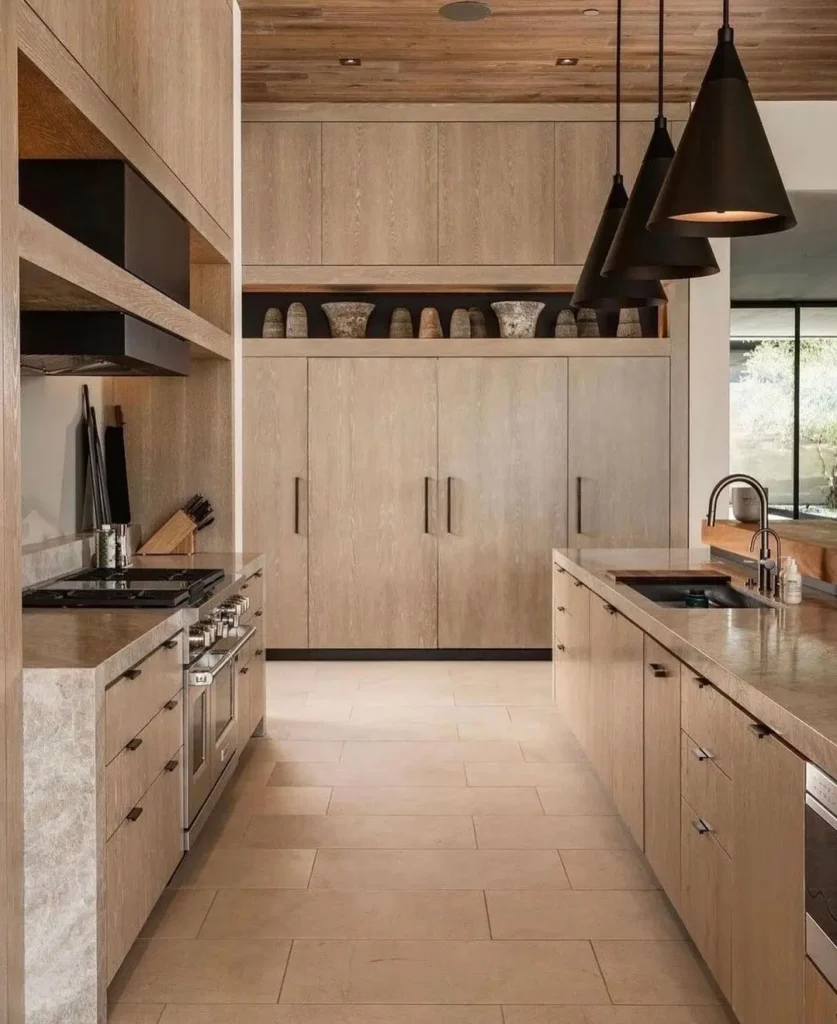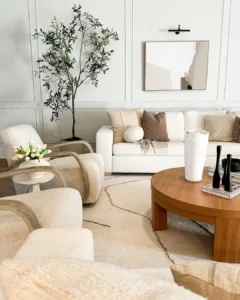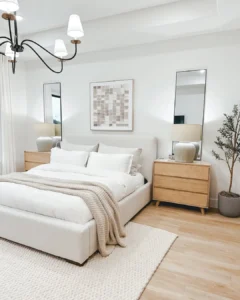In this post, we’re talking about how to design a fresh and simple organic modern kitchen—a space that welcomes you in and invites you to stay.
The kitchen is the heartbeat of most homes. It’s where we gather, create, and start and end our days. So designing a kitchen that reflects both your style and your lifestyle matters more than you might think.
Organic modern design brings together two ideas I love—clean, simple lines and natural, grounded elements. It’s a mix of modern ease and earthy comfort. If you’ve already read our complete guide to Organic Modern Décor, then you know the foundation. Now, it’s time to bring that style into the kitchen.
Whether you’re decorating the kitchen you have or designing one from scratch, this guide will help. We’ll talk about color palettes, textures, lighting, and the little details that make a big difference. Most of all, we’ll focus on how to create a space that feels like home—one that’s beautiful, functional, and uniquely yours.
Start with a Vision: What Makes a Kitchen “Organic Modern”?

Before you dive into picking tile or paint colors, take a moment to define your vision. The organic modern kitchen isn’t just a trend—it’s a mindset. It’s about creating a space that feels calm, intentional, and connected to the world outside your door.
Defining the Look in a Kitchen Context
The heart of organic modern design is balance. Clean lines meet natural textures. Sleek surfaces are softened by earthy details. There’s a quiet confidence in this style—nothing is too precious, and everything has a place.
In a kitchen, that means smooth cabinetry paired with warm wood accents. It means stone countertops, soft lighting, and materials that feel good to the touch. It’s beauty without clutter and function without fuss.
Organic modern kitchens feel collected, not curated. They’re not showrooms—they’re real spaces meant to be used and loved.
Decorating vs. Designing: Know Where You’re Starting
Every kitchen project starts in one of two places. You’re either working with what you have—or you’re starting from scratch.
If you’re decorating an existing kitchen, your focus is on adding style with thoughtful touches. Think hardware swaps, open shelving, handmade pottery, and natural textures.
If you’re designing a new kitchen or renovating, you get to shape the space from the ground up. That means choosing materials, layout, lighting, and flow.
Both paths lead to the same goal: a kitchen that feels like home. Knowing where you’re starting helps you make smart, meaningful choices that align with your space, your lifestyle, and your budget.
If you’re drawn to the simplicity of organic modern design, you might also enjoy our guide on how to design a minimalist kitchen that’s both functional and beautiful.
Decorating Your Existing Kitchen with Organic Modern Decor
Maybe a full renovation isn’t in the cards right now. That’s okay. You don’t need to tear everything out to create a kitchen that feels fresh and calm. With a few thoughtful updates, your existing space can reflect the warmth and beauty of organic modern decor.
Small Changes That Make a Big Impact
Start small. Swap out hardware for something timeless and tactile—matte black, aged brass, or soft nickel. These simple touches bring an earthy, refined feel to even the most basic cabinets.
Next, think about your countertop accessories. Trade bright plastics for wood cutting boards, ceramic canisters, or a vintage crock for utensils. Every object can be both functional and beautiful.
Replace loud or harsh lighting with something softer. A woven pendant or linen-covered shade can add warmth without overwhelming the space.
These are simple moves, but they shift the mood of your kitchen instantly.
Bring in Natural Texture
Organic modern design is all about feel. So bring in textures that connect you to nature.
Try a wood fruit bowl, a linen runner, or a small jute rug by the sink. Add open shelving to showcase simple pottery or glass jars filled with dried goods.
Terracotta planters, woven baskets, or even a slab of raw-edge wood can make the space feel grounded and real.
It’s not about adding more. It’s about choosing better.
Simplify and Curate
In a modern kitchen, clutter is the enemy. But in an organic modern kitchen, clutter is replaced with calm.
Start by clearing off your counters. Keep out only what you use every day—and make sure it looks good, too. A favorite mug, a wooden tray, or a bowl of lemons can do more for a space than a dozen knickknacks.
Use open shelves or glass-front cabinets to style simple, intentional groupings. Think three or four pieces per shelf—nothing more.
Designing a New Organic Modern Kitchen from Scratch
If you’re starting fresh—building or remodeling—you have the chance to design a kitchen that truly reflects your style. An organic modern kitchen begins with intention. Every material, line, and finish should feel like it belongs.
This is your chance to create something peaceful, grounded, and beautiful from the inside out.
Choose Materials That Reflect Nature
The beauty of an organic modern kitchen is its quiet connection to nature. Choose materials that are raw, real, and full of character.
For countertops, think soapstone, honed marble, or quartzite with subtle movement. These surfaces offer beauty without screaming for attention.
Wood cabinetry—especially white oak, walnut, or reclaimed wood—adds warmth, depth, and a natural sense of character. Flat-front doors or simple shaker styles work best—clean, not fussy.
When it comes to backsplashes, lean into handmade. Zellige tile, clay squares, or textured subway tile create a soft, imperfect charm that fits right in.
Choose finishes that feel honest. Materials that age well and grow with your space.
If you love the calm, grounded feel of organic modern but want to explore a slightly different style, take a look at our Japandi-inspired kitchen design ideas for more earthy, functional inspiration.
Layout and Flow
A good kitchen works as well as it looks. In the organic modern style, flow matters just as much as form.
Plan for space to move. Let your kitchen breathe. Avoid cluttered upper cabinets if you don’t need them. Keep the layout open and inviting.
Think about how you move through your kitchen each day. Prep zones, cooking zones, cleanup zones—all should flow naturally. If you entertain, consider adding a spot for gathering, like an island with stools or a cozy breakfast nook nearby.
Light is also part of the layout. Maximize windows. If you’re renovating, consider opening a wall or widening a doorway to let the room feel more open and alive.
The Organic Modern Kitchen Color Palette
Color sets the tone in any space, but especially in the kitchen. In an organic modern kitchen, the palette is calm, quiet, and rooted in nature. It doesn’t shout—it soothes.
It’s less about bold statements and more about harmony.
Warm Neutrals and Earthy Accents
Start with a base of warm neutrals. Think soft white, creamy beige, mushroom, or warm gray. These shades give your space an open, airy feel without feeling stark or sterile.
Then layer in earthy tones. Try a touch of olive green, soft clay, dusty rust, or even a hint of charcoal. These colors ground the space and give it soul.
Use these deeper hues sparingly. A cabinet base, an accent wall, or even a painted pantry door can add just enough warmth and depth.
For a softer take with similar natural tones, explore our guide to bringing Scandinavian decor home for more light, airy inspiration.
The goal is a palette that feels both fresh and lived-in. Like something that belongs.
Using Texture in Place of Bold Color
In organic modern design, texture often takes the place of color. A rough wood shelf, a stone countertop, or a linen shade brings depth without the need for bold tones.
Layer smooth with rough. Matte with glazed. Raw with refined.
Let the materials speak. A warm wood grain or the veining in natural stone can add more interest than any paint color ever could.
This approach keeps the space quiet but never boring.
Light Your Organic Modern Kitchen Intentionally

Light shapes how a kitchen feels. It softens the mood, shifts the energy, and reveals the soul of the space. In an organic modern kitchen, lighting should feel soft, natural, and thoughtfully layered.
It’s not just about brightness—it’s about balance.
Maximize Natural Light
If you’re lucky enough to have natural light, let it shine. Use sheer linen curtains or simple shades that let the light in. Keep window sills clear or add a small planter of herbs to bring in life.
If you’re renovating, consider ways to open up the space. A new window, a skylight, or removing upper cabinets can make a big difference.
Natural light connects the space to the outdoors. It makes everything feel fresher and more inviting.
Organic-Inspired Fixtures
When choosing light fixtures, look for materials that feel handmade and honest. Woven pendants, ceramic sconces, or aged metal finishes work beautifully in an organic modern space.
Hang a pair of pendants over the island. Add a soft-glow sconce above the sink. Use under-cabinet lighting to keep workspaces functional and cozy.
And think about your bulbs, too. Warm white or soft amber tones create a welcoming glow. Avoid harsh, cool lighting—it can break the calm feeling you’ve worked so hard to build.
Decor Styling Tips for an Organic Modern Kitchen
Once your kitchen has the right bones—layout, light, and color—it’s time to add those final touches. This is where the space becomes yours. In an organic modern kitchen, styling should feel natural, not forced.
It’s less about filling shelves and more about telling your story.
Anchor with Intentional Pieces
Choose a few standout pieces that bring both beauty and purpose. A wooden bowl filled with seasonal fruit. A stack of handmade plates. A single ceramic vase with branches from the yard.
If you have open shelves, style them sparingly. Mix everyday dishes with a few vintage finds or natural objects. Leave space between items. Let the eye rest.
A woven basket can hold cookbooks or folded linens. A textured runner adds warmth without taking over. These small pieces do more than decorate—they ground the space.
Highlight Personality and Function
Organic modern design invites real life to show. So let your kitchen reflect the way you live.
Display a favorite mug or a well-worn cutting board. Fill a glass jar with wooden spoons or dried herbs. Let your kitchen tools double as decor.
Add a plant by the window or a few fresh sprigs in a vase on the island. Bring life into the room without overthinking it.
The key is this: only bring in what you love and use. Your kitchen doesn’t need to be perfect. It just needs to feel like you.
Sustainable Choices for a Grounded Kitchen
An organic modern kitchen isn’t just about how it looks—it’s about how it feels. It should reflect your values and your way of living. Choosing sustainable materials and mindful practices adds depth and meaning to your space.
It’s about creating a kitchen that not only looks good but does good, too.
Eco-Friendly Materials and Finishes
Start with natural, long-lasting materials. Look for cabinets made from FSC-certified wood. Choose countertops in recycled stone or sustainably sourced marble.
Opt for low-VOC paints and natural sealants. These options are better for the air you breathe and the planet, too.
Build with the future in mind—choose finishes that last and grow better with time. Fewer replacements mean less waste—and a kitchen that ages gracefully.
Budget-Friendly Sustainability
You don’t have to spend big to make thoughtful choices. Sometimes the most sustainable option is already in your home.
Give old pieces a new purpose. Reuse shelves, refinish cabinets, or thrift for vintage bar stools. These items often come with more charm and character than anything new.
Trade paper for cotton or linen cloths that work hard and look beautiful too. Use glass jars for pantry storage. Add a compost bin under the sink or start small with countertop options.
Every sustainable choice tells a story. It’s not about being perfect—it’s about being mindful.
Pulling Together Your Organic Modern Kitchen Plan
By now, you’ve gathered the ideas, the inspiration, and the vision. Whether you’re decorating your current space or designing something brand new, creating an organic modern kitchen comes down to intention.
It’s about taking one thoughtful step at a time.
Customize Your Approach
Start by looking at how your kitchen works for you now. What do you love? What feels off?
If you’re decorating, begin with small changes. Shift the lighting. Style the shelves. Add warmth with texture and tone.
If you’re renovating or building, let simplicity guide your decisions. Choose natural materials. Prioritize flow and function. Build a kitchen that feels timeless, not trendy.
Remember, this is your space. Let it reflect your rhythms, your routines, and the way you love to gather.
There’s no one way to do this right—there’s only what feels right to you.
Quick Checklist to Get Started
Here’s a simple list to help bring your kitchen into focus:
- Choose a soft, earthy color palette
- Swap hardware for organic finishes like matte black or aged brass
- Add natural textures—wood, linen, ceramic, stone
- Clear the clutter and style with intention
- Bring in greenery, branches, or herbs
- Choose lighting that’s soft and grounded
- Layer in decor that’s functional and beautiful
Let each step build on the last. With time, your kitchen will start to reflect the peace and beauty of an organic modern home.
Conclusion
Designing a fresh and simple organic modern kitchen isn’t about chasing perfection. It’s about creating a space that feels calm, thoughtful, and truly lived in.
Whether you’re working with what you have or building from scratch, this style meets you where you are. Let your choices be guided by what feels good, works well, and brings peace to your daily routine.
If you’re new to the style or want a deeper look at the philosophy behind it, be sure to check out our complete guide to Organic Modern Décor.
Start small, trust your instincts, and let your kitchen tell your story—one natural detail at a time.
Happy decorating!
Frequently Asked Questions
How do I make my kitchen feel organic without a full remodel?
Start by working with what you already have. Declutter your countertops. Swap out hardware for warm, natural finishes like brushed brass or matte black. Add wooden accents, neutral linens, and greenery. Even small changes—like a new light fixture or open shelving—can shift the entire mood of your space.
Try styling with handmade ceramics or a bowl of fruit on the counter. These simple touches create a more grounded, intentional feel.
Can I blend organic modern with other styles?
Absolutely. Organic modern is a flexible style that pairs beautifully with others. If you love farmhouse, keep the wood and mix in sleeker lines. If you lean coastal, soften the palette with sandy hues and breezy textures. Even industrial elements—like black metal or concrete—can complement organic pieces when balanced with warmth and texture.
The key is balance. Let nature lead, and don’t be afraid to mix what feels true to your story.
What are the best natural materials for small kitchens?
In smaller spaces, light and texture matter most. Choose pale woods like white oak or birch to keep things open and bright. Use matte or honed finishes to soften hard surfaces. Stone countertops, clay tile, and glass cabinet fronts can help reflect light without adding visual weight.
Linen curtains, jute rugs, and small touches of greenery bring life without cluttering the space. Keep your palette light and cohesive for the most impact.
Is it okay to mix wood tones and finishes?
Yes—mixing wood tones can actually make your kitchen feel more natural and layered. Just be mindful of contrast. Stick to two or three tones max, and try to repeat each one at least once in the room.
For example, if your cabinets are a warm oak, you might add a walnut stool and a reclaimed pine shelf. Tie it all together with a neutral palette and natural textures.
Mixing wood tones adds character. It shows that your space was built over time, not picked from a catalog.
Should I avoid upper cabinets in an organic modern kitchen?
Not necessarily. While open shelving can add airiness, upper cabinets still have their place—especially if you need the storage.
If you do use upper cabinets, keep them sleek and simple. Flat-panel fronts or glass inserts work well. You can also lighten the look by choosing cabinets in a warm white or soft neutral that blends with the wall color.
The goal is to keep things feeling open, clean, and easy. Use what works for your space and your needs.
The following articles will provide you with additional insights, tips and ideas to design your Organic Modern Kitchen:
- 5 Key Elements of Scandinavian Design
- The Power of Less: How to Achieve a Minimalist Look in Your Home
Pin this post for later!




